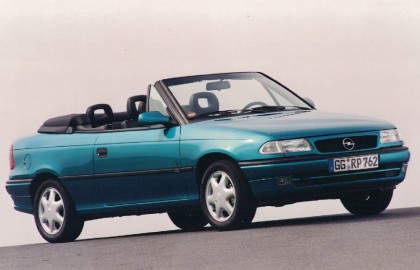Astra MK3 1992-1998
In 1991 the successor to the Kadett got a new name: the Astra. In spite of the fact that the exterior dimensions were very similar to its predecessor, Opel preferred to identify the Astra with the Vectra. This is because the car looked very different, very modern, very tasteful and in not at all middle of the road any more. The lines are curved and fluid. The addition of an extra third side window improved the rear view immensely compared to its predecessor. Safety improvements can be found in the increased torsional stiffness and the protective bars in the doors.
Models and engines
The Astra offers a broad assortment of models and designs. In addition to the three-door and five-door hatchback, there is also a four-door sedan and a five-door station. An increasing demand for cars with boots and station models ensued. In salesmen’s circles the styling, space and practical layout were praised: the rear floor is completely flat and the backrest could be folded away into two sections.
The sedan is also the basis for the cabriolet which was built by Bertone and was launched later. The engine range consisted of a 14i, a 16i, a 18i (also in a 16v model) and a 20i, including a 20i-16v. For the frequent driver there was a choice of a 17D and a 17TD engine. The level of equipment were indicated by the well-known designations such as GL, GLS, GT, Sport, CD and CDX.
In 1995 a number of new designations were added (/as replacements) such as Club, Fresh, Edition, Njoy, Season and Sprint. These were action models which were derived from the equipment levels mentioned earlier.
The Astras built in 1991-1994 turned out to be very prone to rust, so from 1994 onwards the body work was galvanised entirely and other kinds of sealants were used. In 1995 the Astra got a facelift, where the car was equipped with a new grille, headlights with a more curved corner, standard white indicators, standard plate on the boot between the rear lights (both were only available on the GSi before the facelift), dark rear lights, mouldings, new side mirrors and new bumpers. The interior was renewed and from then on was only available in the basic colour black.
Astra GSi
With its introduction In 1991 Opel copied the Kadett E GSi by also launching a fast model for the Astra F. The basic engine for this model is a two litre power source with two valves per cylinder (C20NE). This provides 115 hp and lets the GSi go from 0 to 100 km/hour in 9.5 seconds (manufacturers statement). The most powerful version is equipped with the 150 hp strong 2 litre 16V. Partly due to the high torque for this time of 196 Nm this engine is able to go from 0 to 100 km/hour in 8 seconds flat. In 1993 the C20NE was replaced by the C18XE, a 1.8 litre engine with 16 valves.
This GSi looks very different to the standard three-door hatchback, while the steel part of the bodywork remains almost identical. The GSi is equipped with more hefty rear and fore bumpers, a different grille, side skirts, air vents in the bonnet and a large roof spoiler on the tailgate. In addition the antenna was placed at the back of the roof, in contrast to its position on the left hand rear fender on other designs. The front indicators are white instead of orange. There are no side indicators on the GSi and the rear lights are darker coloured. Between the rear lights a plate is mounted on the tailgate and the GSI comes with tinted glass.
The GSi in the Netherlands and Belgium is very well equipped as a matter of course. The car is delivered with an on board computer, ABS, power steering and disk brakes all around. The models without air conditioning come with a standard tilt and slide sunroof until the MY ’94. Recaro sports seats are also included in the package. The 2.0 16V comes with standard 15 inch light alloy wheels and up to the MY’94 is equipped with front fog lights. Traction control is also standard in this model. Compared to the 2.0 8V and the 1.8 16V, the 2 litre 16V has an extra stabilizing bar on the rear axle. In addition all original Dutch and Belgian cars were prepared for pretty much all possible options. After the facelift for the GSi these options were only available for extra cost.
The GSi model also underwent a facelift. From 1994 onwards fans have to cope without spoilers, broad bumpers and air scoops in the bonnet. The GSi only looks different because of the badge on the side mouldings. In addition mid 1995 the GSi was forced to exchange its 150 hp two litre 16v power source for the new generation of Ecotecmotor with the same engine size but 14 hp less power. The five door hatchback and the station could also be purchased in a GSi model from then on. This mainly meant an engine upgrade with another chassis.
The last Astra F left in the showroom in the Netherlands in 1998. Over the course of seven years Opel had sold 4.3 million worldwide.


